Die Wahl eines geeigneten Schlafsacks und einer passenden Isomatte ist zu Beginn des Wanderhobbys keine einfache Aufgabe. Dieser Leitfaden zeigt dir, welche Optionen es gibt und worin sie sich in der Praxis unterscheiden.
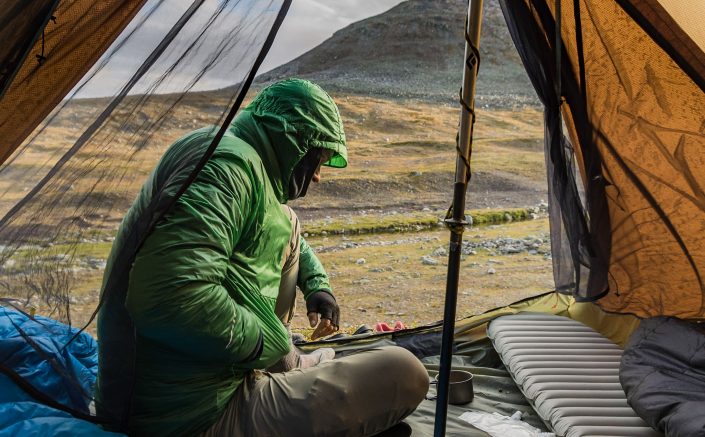
Mikko arbeitet als Outdoorspezialist in unserem Geschäft in Turku. Er verfügt über fast 20 Jahre Erfahrung in der Beratung von Wanderern, und wir sind sicher, dass er vielen unserer Kundinnen und Kunden ein bekanntes Gesicht ist. Mikko ist außerdem einer der Outdoor-Experten für unsere Outdoor-Ratgeber.
1. Wie wählt man einen guten Schlafsack aus?
Das Erste, woran du bei der Auswahl eines Schlafsacks denken solltest, ist sein Verwendungszweck. Wird der Schlafsack auf langen Wanderungen getragen oder hauptsächlich beim Campen in der Nähe deines Fahrzeugs oder vielleicht in der Nähe deiner Hütte verwendet? Bei welchem Wetter und in welchem Klima wirst du darin schlafen? Wie hoch ist dein Budget?
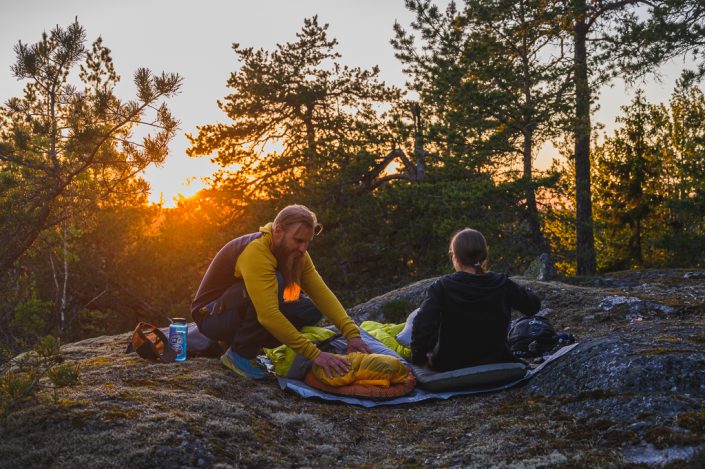
Wenn der Schlafsack nicht über längere Strecken getragen wird, spielen Gewicht und Packmaß keine große Rolle. In diesem Fall musst du lediglich sicherstellen, dass der Schlafsack für den vorgesehenen Einsatzbereich warm genug ist.
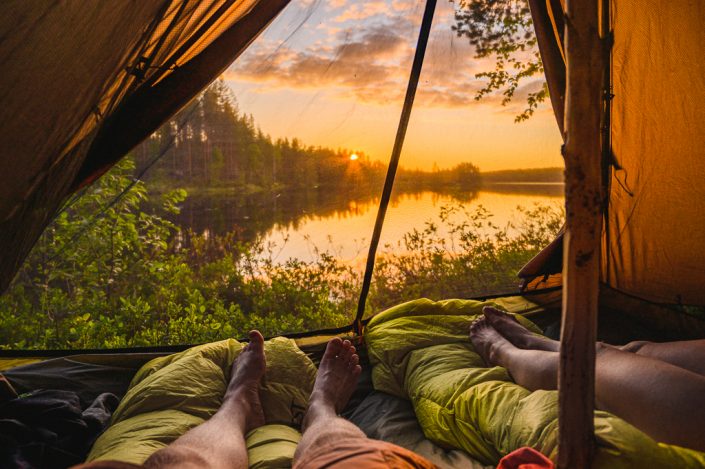
Wenn der Schlafsack jedoch beim Wandern verwendet wird und du planst, deine gesamte Ausrüstung im Rucksack zu tragen, solltest du mehr auf das Gewicht und das Packmaß des Schlafsacks achten. Du solltest immer einen Schlafsack wählen, der etwas wärmer ist als das Klima, in dem du ihn verwenden möchtest – natürlich in vernünftigem Maße. Ein Winterschlafsack ist im Sommer viel zu warm und bringt zudem unnötiges Gewicht mit sich.
Ein guter Schlafsack hält dich warm, ist aber dennoch nicht zu schwer. Eine Sommerwanderung in Lappland erfordert möglicherweise einen Schlafsack, der dich auch bei Temperaturen nahe dem Gefrierpunkt noch angenehm warm hält. Ein solcher Schlafsack ist vielseitig einsetzbar und bietet von Frühling bis Herbst Komfort. Für den Winter ist er jedoch in der Regel nicht warm genug.
Die Komforttemperatur eines Schlafsacks
Die Idee des Schlafsacks besteht darin, eine isolierende Schicht zwischen dir und den Elementen zu bilden. Dein Körper erzeugt Wärme, und der Schlafsack wirkt als Barriere zwischen der wärmeren Innenseite und der kälteren Außenluft.
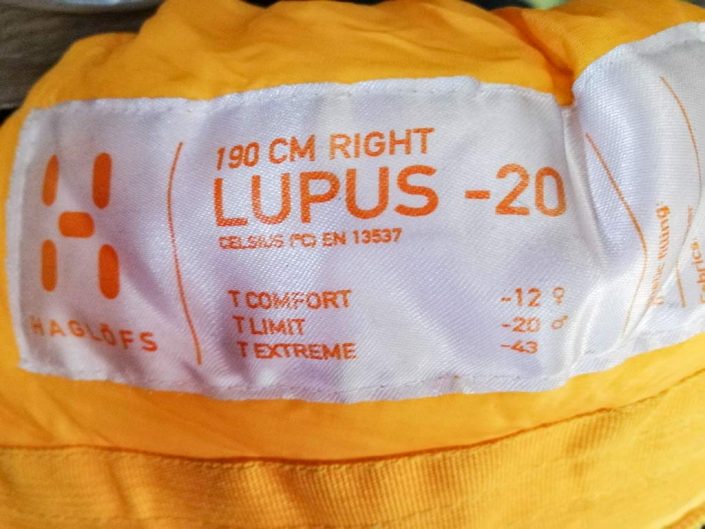
Es gibt sogenannte Drei-Jahreszeiten-Schlafsäcke, Sommerschlafsäcke und viele andere verwirrende Begriffe, aber der einfachste Ansatz ist, sich die Bedingungen vorzustellen, unter denen du den Schlafsack verwenden wirst, und diese mit der sogenannten Komforttemperatur zu vergleichen.
Vereinfacht ausgedrückt gibt die Komforttemperatur an, bei welcher Temperatur du noch bequem in deinem Schlafsack schlafen kannst. In unserem Onlineshop geben wir die Komfortwerte getrennt für Männer und Frauen an, während Hersteller oft zwischen Komfort- und Limittemperatur unterscheiden. Dabei bezieht sich die Komforttemperatur auf die angenehme Nutzungstemperatur für Frauen, während die Limittemperatur die entsprechende Temperatur für Männer angibt. Die Extremtemperatur gibt an, bis zu welcher Temperatur der Schlafsack noch verwendet werden kann, ohne dass eine Unterkühlung eintritt.
Du kannst die Temperaturangaben verschiedener Hersteller miteinander vergleichen, aber es gibt auch andere Faktoren, die dein Wärmeempfinden beeinflussen – und unterschiedliche Menschen empfinden Kälte auf unterschiedliche Weise. Der einzige Weg, deine persönliche Komfortzone herauszufinden, ist das Testen von Schlafsäcken und das Ausprobieren verschiedener Optionen.
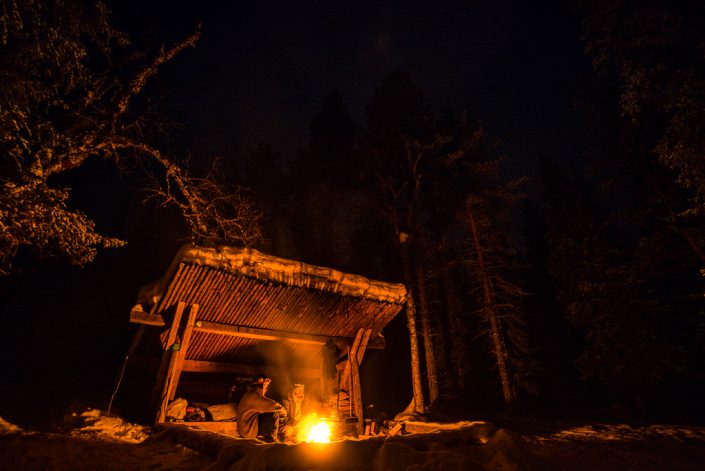
Warm zu bleiben hängt nicht nur von deinem Kälteempfinden und der Art deines Schlafsacks ab. Es spielen auch andere Faktoren eine Rolle, wie etwa deine Isomatte, deine Kleidung, dein Hungergefühl, wie kalt es beim Zubettgehen war und wo du die Nacht verbringst – unter freiem Himmel, in einem offenen Unterstand oder in einem Zelt, das dich vor dem Wind schützt.
Was ist der Unterschied zwischen Kunstfaser- und Daunenfüllung bei Schlafsäcken?
Die Füllung eines Schlafsacks besteht entweder aus Kunstfaser, Daunen oder einer Mischung aus beidem. Vergleicht man Kunstfaser- und Daunenschlafsäcke mit derselben Komforttemperatur, sind sie natürlich gleich warm – allerdings ist der Daunenschlafsack in der Regel kleiner und leichter als sein Pendant mit Kunstfaserfüllung. Das liegt daran, dass Daunen ein effizienterer Isolator sind als synthetische Fasern.
Kunstfasern sind in der Regel widerstandsfähiger gegen Feuchtigkeit, obwohl heutzutage viele speziell behandelte Daunenfüllungen erhältlich sind, die ebenfalls Feuchtigkeit gut standhalten. Wenn der Schlafsack nass wird, trocknet die Kunstfaserfüllung deutlich schneller.
Daunen lassen sich außerdem viel besser komprimieren, sodass du den Schlafsack auf ein sehr kleines Packmaß reduzieren kannst.
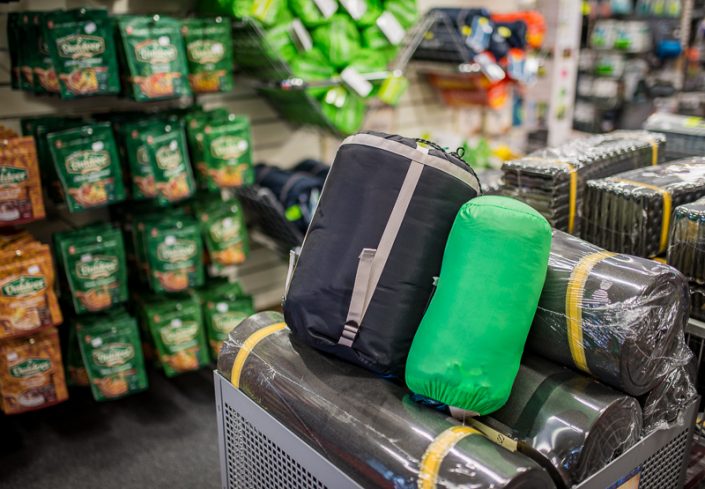 Ein Bild von Schlafsäcken mit Daunen- und Kunstfaserfüllung bei gleicher Komforttemperatur. Der Schlafsack mit Daunenfüllung lässt sich noch weiter auf ein kleineres Packmaß komprimieren.
Ein Bild von Schlafsäcken mit Daunen- und Kunstfaserfüllung bei gleicher Komforttemperatur. Der Schlafsack mit Daunenfüllung lässt sich noch weiter auf ein kleineres Packmaß komprimieren.
Wenn du einen leichten Schlafsack suchst, der sich auf ein möglichst kleines Packmaß komprimieren lässt, ist ein Daunenschlafsack die beste Wahl. Wenn Gewicht und Größe jedoch keine allzu große Rolle spielen, sind Schlafsäcke mit Kunstfaserfüllung die bessere Option, da sie günstiger sind.
Auf dem Markt gibt es unterschiedliche Qualitäten von Daunen, deren Qualität mit dem FP-Wert (Fill Power) angegeben wird. Je höher der FP-Wert, desto hochwertiger ist die Daune und desto besser sind ihre Isoliereigenschaften. Das bedeutet ein kleinerer und leichterer Schlafsack bei vergleichbarer Komforttemperatur. FP600 liegt am unteren Ende der Skala, während FP900 eine hochwertige Daune kennzeichnet.
Alle Daunenprodukte von Scandinavian Outdoor stammen aus ethisch zertifizierten Produktionsstätten.
 Eine weitere Alternative zum klassischen Schlafsack ist der Quilt. Ein Quilt ist eine abgespeckte Version des Schlafsacks. Beim Schlafsack wird die Füllung unter dem Schläfer zusammengedrückt und verliert dadurch einen Großteil ihrer Isolierwirkung. Beim Quilt wurde der untere Teil bewusst ohne Füllung gefertigt, was ihn zu einer guten Wahl macht, wenn du Gewicht sparen möchtest. Der Quilt wird in der Regel an der Isomatte befestigt und bleibt so an Ort und Stelle, auch wenn du dich darin drehst.
Eine weitere Alternative zum klassischen Schlafsack ist der Quilt. Ein Quilt ist eine abgespeckte Version des Schlafsacks. Beim Schlafsack wird die Füllung unter dem Schläfer zusammengedrückt und verliert dadurch einen Großteil ihrer Isolierwirkung. Beim Quilt wurde der untere Teil bewusst ohne Füllung gefertigt, was ihn zu einer guten Wahl macht, wenn du Gewicht sparen möchtest. Der Quilt wird in der Regel an der Isomatte befestigt und bleibt so an Ort und Stelle, auch wenn du dich darin drehst.
Tipps zur Verwendung eines Schlafsacks
Es ist ratsam, den Schlafsack zunächst unter weniger anspruchsvollen Bedingungen zu testen, um herauszufinden, wie gut er mit dem Wetter zurechtkommt, bevor man zu einer richtigen Wanderung aufbricht. Mit einem Inlett kannst du deinen Schlafsack länger sauber halten und zusätzlich Wärme gewinnen. Vor dem Schlafengehen solltest du die Isomatte – insbesondere wenn sie mit Daunen gefüllt ist – eine Weile aufplustern lassen. Am Morgen solltest du den Schlafsack gut lüften, bevor du ihn verstaust. Manche Wanderer verwenden keinen Packsack, sondern verstauen den Schlafsack direkt im Rucksack. Es ist jedoch immer eine gute Idee, den Schlafsack vor Regen zu schützen, damit er im Rucksack nicht nass wird.
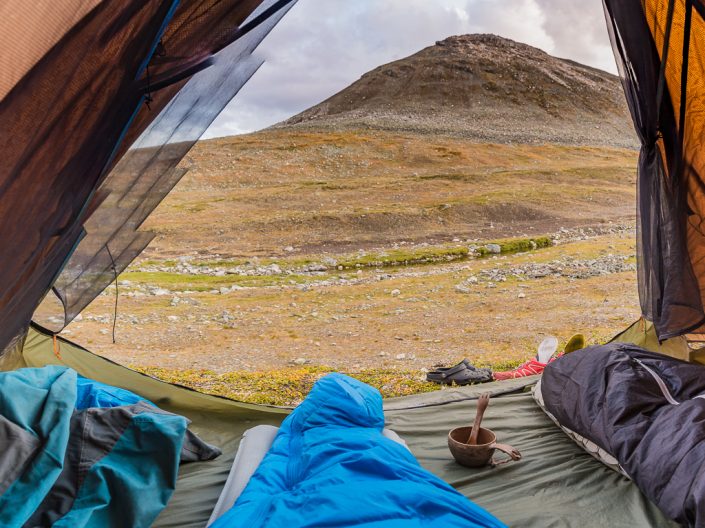 Wenn du planst, im Sommer in Lappland zu wandern, solltest du einen Schlafsack und eine Isomatte wählen, die auch für Temperaturen um den Gefrierpunkt geeignet sind. So stellst du sicher, dass dir auch bei plötzlichem Kälteeinbruch warm bleibt.
Wenn du planst, im Sommer in Lappland zu wandern, solltest du einen Schlafsack und eine Isomatte wählen, die auch für Temperaturen um den Gefrierpunkt geeignet sind. So stellst du sicher, dass dir auch bei plötzlichem Kälteeinbruch warm bleibt.
Wenn du das ganze Jahr über campst und wanderst, solltest du das Gesamtbild im Blick behalten. In diesem Fall reicht ein einzelner Schlafsack nicht aus, denn im Winter benötigst du einen Winterschlafsack, der wiederum im Sommer viel zu warm wäre. Es ist daher sinnvoll, zwei oder sogar drei verschiedene Schlafsäcke zu besitzen. Eine Möglichkeit wäre, im Sommer einen Schlafsack zu verwenden, der für Temperaturen knapp über dem Gefrierpunkt ausgelegt ist, und im Frühling sowie Herbst einen Schlafsack, der bis -10 °C Komfort bietet. Im Winter könntest du dann beide Schlafsäcke ineinander stecken und so gemeinsam nutzen.
2. Wie wählt man eine gute Isomatte aus?
Neben dem Schlafsack ist die Isomatte der wichtigste Faktor, um warm zu bleiben. Wenn du in einem Schlafsack schläfst, wird die Füllung unter dir zusammengedrückt und verliert den Großteil ihrer Isolierfähigkeit. Die Isolationswirkung des Schlafsacks entsteht durch die Luft, die sich zwischen den Daunen oder Kunstfasern befindet. Die nötige Isolierung unter dem Körper wird daher hauptsächlich von der Isomatte übernommen – ein warmer Schlafsack allein reicht nicht aus.
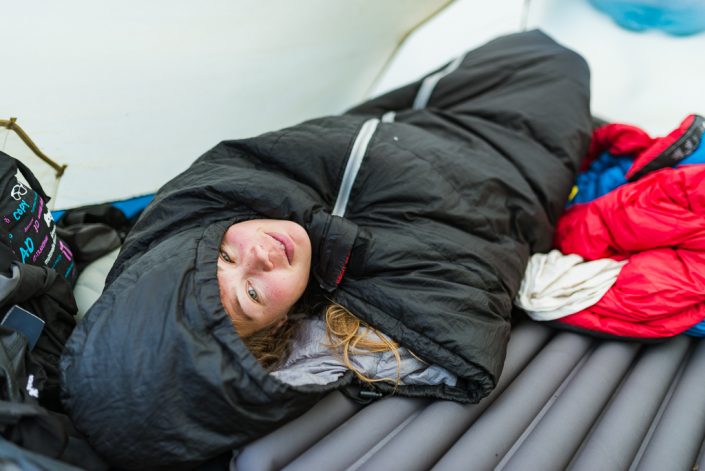
Ein zu kalter Schlafsack lässt sich auf viele Arten ausgleichen, während eine schlecht isolierende Isomatte nur schwer zu ersetzen ist. Deshalb solltest du beim Kauf besonders auf die Isolierfähigkeit der Matte achten, die durch den R-Wert angegeben wird. Je höher der R-Wert, desto besser ist die Isolierung der Matte.
Allgemein kann man sagen, dass Isomatten mit einem R-Wert unter 3 für den Sommer gedacht sind. Drei-Jahreszeiten-Matten sollten einen R-Wert über 3 haben, und eine Wintermatte sollte einen R-Wert von 5 oder mehr aufweisen.
Was ist der Unterschied zwischen einer geschlossenzelligen Schaumstoffmatte und einer selbstaufblasenden Isomatte?
Isomatten gibt es hauptsächlich in zwei Ausführungen: geschlossenzelliger Schaumstoff und selbstaufblasende Modelle. Geschlossenzellige Schaumstoffmatten sind in der Regel günstiger, widerstandsfähiger gegen Zerknittern und unempfindlich gegenüber Feuchtigkeit oder sogar Funkenflug vom Lagerfeuer. Eine solche Matte lässt sich auch gut als Sitzunterlage bei einer Pause oder beim abendlichen Verweilen am Feuer verwenden.
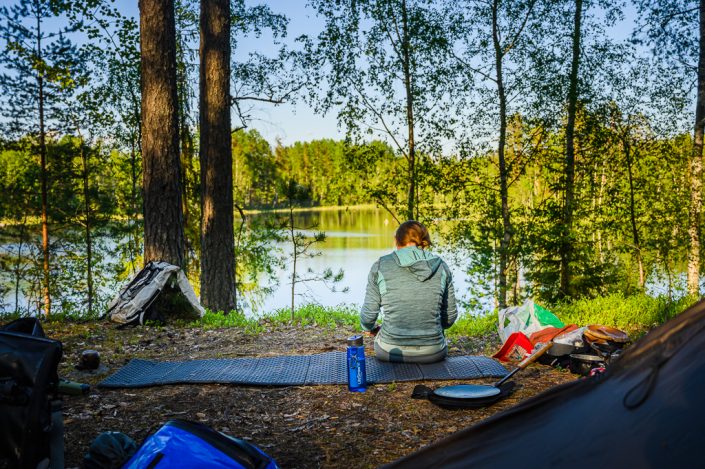
Geschlossenzellige Schaumstoffmatten sind sehr leicht, aber recht sperrig. Viele Rucksäcke verfügen jedoch über praktische Befestigungsmöglichkeiten, mit denen sich solche Matten außen am Rucksack befestigen lassen. Der R-Wert solcher Matten liegt oft unter 4, sodass sie nicht zu den wärmsten Optionen gehören.
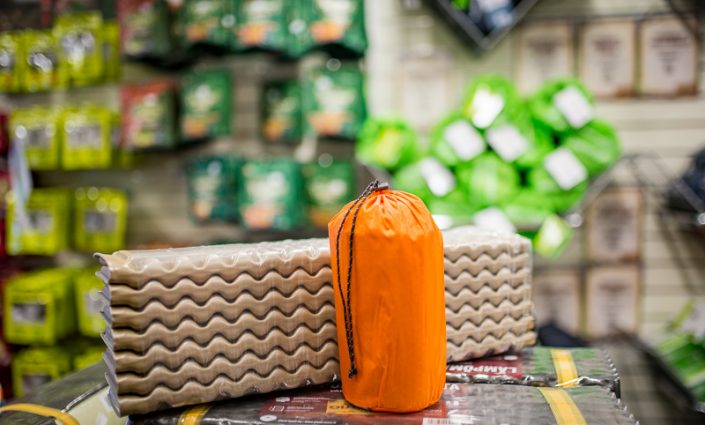 Ein Größenvergleich zwischen einer geschlossenzelligen Schaumstoffmatte und einer aufblasbaren Matte. In diesem Fall hat die aufblasbare Matte die Nase vorn.
Ein Größenvergleich zwischen einer geschlossenzelligen Schaumstoffmatte und einer aufblasbaren Matte. In diesem Fall hat die aufblasbare Matte die Nase vorn.
Aufblasbare Isomatten lassen sich auf ein kleineres Packmaß komprimieren. Besonders die dickeren Modelle bieten einen höheren Schlafkomfort, sind jedoch anfälliger für Beschädigungen als geschlossenzellige Schaumstoffmatten. Ein durchstochene Matte lässt sich zwar leicht reparieren – Reparatursets sind oft im Lieferumfang enthalten – allerdings kann das Auffinden des Lochs mitunter schwierig sein.
Es gibt eine große Auswahl an aufblasbaren Isomatten mit R-Werten zwischen 1 und 9. Diese lassen sich in zwei Haupttypen unterteilen: Erstens die sogenannten selbstaufblasenden Matten, bei denen man nur ein Ventil öffnen muss, damit sich die Matte langsam mit Luft füllt. Danach wird sie mit dem Mund vollständig aufgeblasen. Diese Matten sind meist 1 bis 4 cm dick. Zweitens gibt es Luftmatratzen, die mit einer integrierten oder separaten Pumpe oder mit einem speziellen Packsack aufgeblasen werden – ein schneller und einfacher Vorgang. Diese Modelle können bis zu 9 cm dick sein, und Wintervarianten enthalten zusätzlich Daunen- oder Kunstfaserfüllung, um eine Isolierung mit einem R-Wert von bis zu 9 zu erreichen.
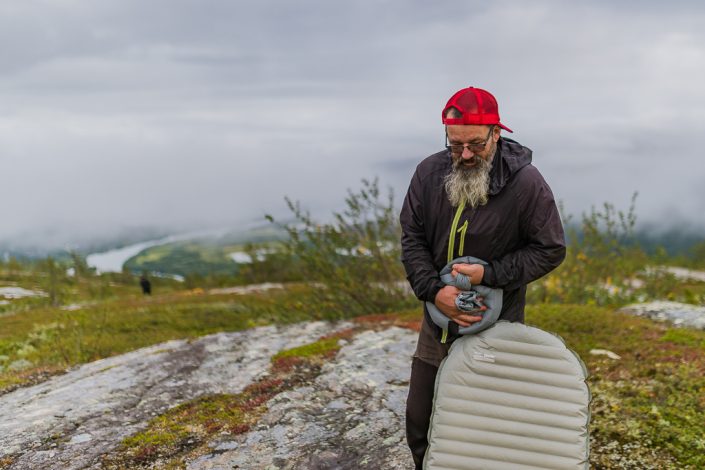
Wenn du eine Isomatte suchst, die sich auf ein möglichst kleines Packmaß reduzieren lässt, solltest du eine aufblasbare Matte wählen. Wenn das Packmaß keine große Rolle spielt, ist die günstigere geschlossenzellige Schaumstoffmatte eine gute Wahl. Für den Winter ist die wärmste Option eine aufblasbare Matte. Du kannst im Winter auch zwei Isomatten übereinander verwenden. Eine sinnvolle Ergänzung zu einer aufblasbaren Matte ist eine Schaumstoffmatte mit reflektierender Folienoberfläche, die zur Körperseite hin platziert wird, um die Körperwärme zurückzuleiten.
Tipps zur Auswahl einer Isomatte
Für die meisten Menschen ist eine hochwertige aufblasbare Isomatte in der Regel die komfortabelste Wahl. Zusätzlich kannst du eine geschlossenzellige Schaumstoffmatte mitnehmen, die du gegebenenfalls kürzen kannst, um Gewicht zu sparen. Die Schaumstoffmatte kannst du dann als Sitzunterlage und als zusätzliche Isolierschicht unter der aufblasbaren Matte verwenden. Wenn du zwei Isomatten mitführst, kannst du bei der aufblasbaren Matte zu einem leichteren und kompakteren Modell greifen – so sparst du sowohl Gewicht als auch Platz.
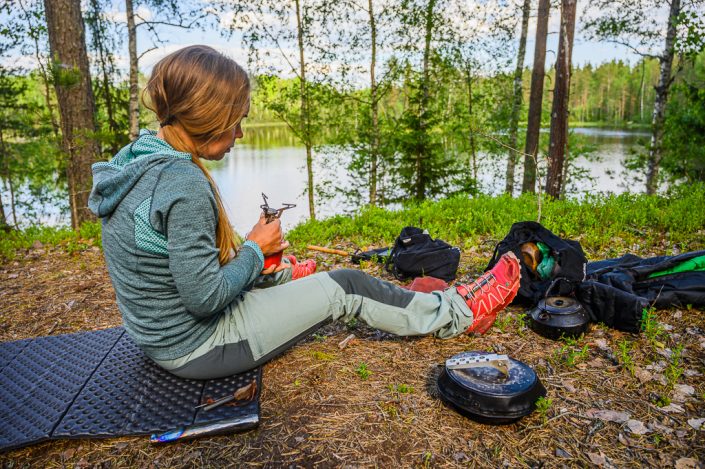
Wenn du das ganze Jahr über im Freien schläfst, ist es sinnvoll, von Anfang an in eine gut isolierende Isomatte zu investieren. Einige aufblasbare Matten haben einen hohen R-Wert und lassen sich dennoch auf ein kleines Packmaß komprimieren. Eine solche Matte kann das ganze Jahr über verwendet werden – bei Bedarf ergänzt durch eine geschlossenzellige Schaumstoffmatte als zusätzliche Isolationsschicht.
Wie sorgt man für warme Nächte beim Wandern?
Auf einer Wanderung musst du mit dem auskommen, was du dabeihast. Wenn dich kaltes Wetter überrascht und du befürchtest, dass Schlafsack und Isomatte nicht ausreichen, um dich warm zu halten, gibt es einige Tricks, mit denen du die Situation verbessern kannst.
Zunächst solltest du nicht frierend ins Bett gehen. Wärm dich vorher mit ein paar Übungen auf oder setz dich ans Feuer, bevor du in den Schlafsack kriechst. Ein Inlett kann dir etwas zusätzliche Wärme spenden, und ein Kissen sorgt für mehr Komfort – das kannst du dir auch einfach aus einem wasserdichten Beutel oder Ähnlichem basteln, den du mit Kleidung füllst.
Viele bevorzugen es, in einer warmen und trockenen Merinounterwäsche zu schlafen – auch trockene Socken solltest du vor dem Schlafengehen anziehen. Darüber hinaus kannst du weitere Kleidungsschichten anziehen. Luftige Kleidung wie Daunenjacken, Fleece- oder Wollkleidung isolieren besonders gut. Achte jedoch darauf, dass du dich im Schlafsack nicht zu eng einpackst.
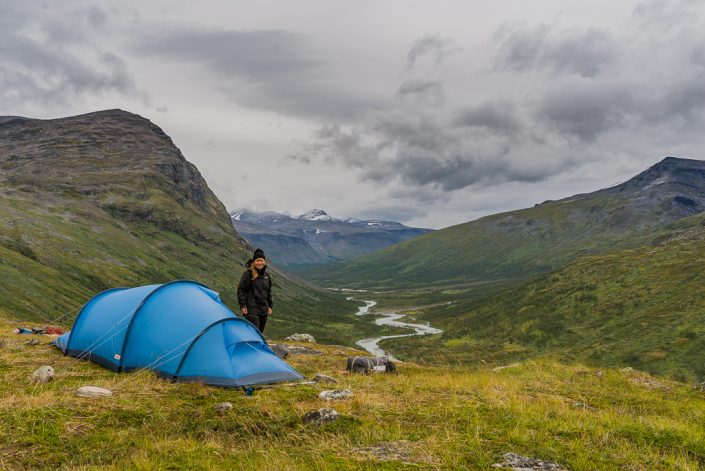
Du solltest vor dem Schlafengehen eine ordentliche Mahlzeit zu dir nehmen und auf eine ausreichende Flüssigkeitszufuhr achten. Wenn du eine Trinkflasche hast, die kochendes Wasser aushält und einen dichten Verschluss hat (zum Beispiel eine Nalgene-Flasche), kannst du sie als Wärmflasche im Schlafsack verwenden.
Die Zehen sind meist der erste Körperteil, der kalt wird – deshalb solltest du warme und trockene Socken tragen. Manche Menschen verlieren auch Wärme im Hüftbereich, hier kann ein wattierter Rock oder eine um die Hüften gewickelte Daunenjacke helfen, warm zu bleiben.
Zum Schluss noch ein Tipp: Wenn du auf die Toilette musst, geh sofort! Andernfalls verlierst du unnötig Schlaf, denn früher oder später musst du den Schlafsack ohnehin verlassen.
Schlafsäcke und Isomatten für den ganzjährigen Einsatz
Wenn du zu allen Jahreszeiten im Freien schläfst, reicht ein einzelner Schlafsack nicht aus. Ein guter Winterschlafsack ist so schwer, dass es im Sommer keinen Sinn macht, ihn mit sich herumzutragen – und zudem ist er viel zu warm, um darin bequem zu schlafen.
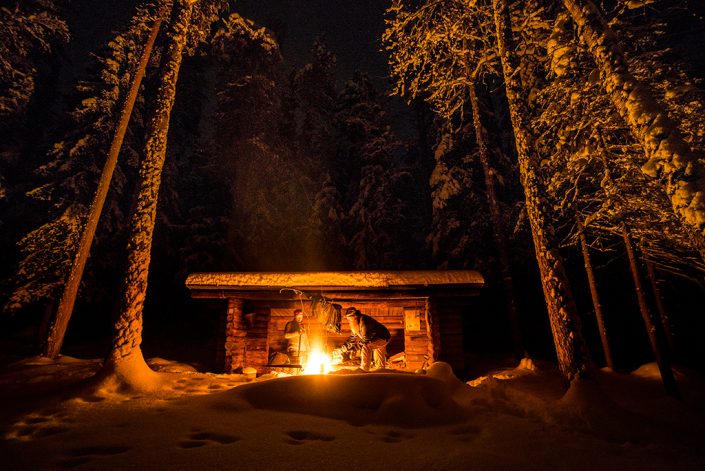
Wenn Wandern zu einem ganzjährigen Hobby wird, solltest du beim Kauf von Schlafsack und Isomatte das große Ganze im Blick behalten – damit sie dich unter allen Bedingungen bestmöglich unterstützen.
Wenn du gerne im Sommer in Lappland wanderst, solltest du trotzdem einen Schlafsack wählen, in dem du bei Temperaturen nahe dem Gefrierpunkt schlafen kannst. Es gibt viele leichte Daunenschlafsäcke, die dafür geeignet sind und sich dennoch angenehm tragen lassen. In südlicheren Wintern reicht oft ein Schlafsack, der bis etwa -10 °C komfortabel ist. Bei Wintertouren in Lappland kann selbst ein Modell mit einer Komforttemperatur von -20 °C nicht ausreichen. Du brauchst also unter Umständen drei verschiedene Schlafsäcke – oder du kombinierst den Sommerschlafsack mit einem Schlafsack, der für südliche Winter geeignet ist. In diesem Fall solltest du sicherstellen, dass der Winterschlafsack groß genug ist, um den anderen aufzunehmen und noch etwas Platz zu lassen.
Es gibt einige recht leichte Isomatten mit gutem R-Wert, die sich das ganze Jahr über verwenden lassen. Trotzdem kann es sinnvoll sein, im Sommer eine leichtere Matte und im Winter eine etwas robustere Variante zu nutzen. Im Winter empfiehlt es sich zusätzlich, eine Schaumstoffmatte mitzunehmen. Diese kann als Sitzunterlage dienen und bietet zusätzliche Isolierung sowie Schutz für die aufblasbare Matte.














